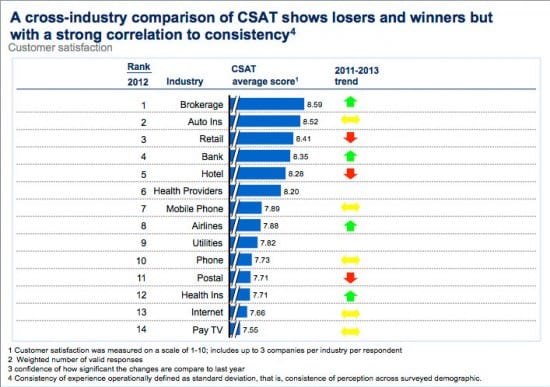New Mckinsey research highlights how to improve satisfaction
McKinsey's research on customer satisfaction highlights that consistency of service delivery is crucial. They have themed their findings around the 3Cs of Customer Satisfaction, thats:
- Customer-Journey Consistency
- Emotional Consistency
- Communication Consistency
We all know that the economic climate and easier on-line access to goods and services, increases customer choice and this can lead to lower levels of loyalty, if we don't look after customers after the first touchpoint and beyond.
We're recommending this research since it shares research on customer satisfaction across 14 sectors: Brokerage, banks and health providers ranked high whereas car insurance, retail, telecoms and postal services were less favourable as shown on the graph:

Findings highlighted that brand and service are key to customers, and research from 27,000 USA American consumers across 14 industries found that effective customer journeys are important.
Let's look at the 3 CS that the report recommends are important for effectiveness.
1. Customer Journey Consistency
During each interaction with the company, the company needs to ensure consistency through well thought through processes, rules and workflow. There are increased pressures due to the multi-contact channels available, and the infrastructure of the company, though the research highlights that it's crucial to deliver consistently each time.
'The fact is that consistency on the most common customer journeys is an important predictor of overall customer experience and loyalty.'
2. Emotional Consistency
The research showed that a sense of trust is created when a consumer takes on a positive experience which in turn stimulates positive emotions.
'The biggest drivers of satisfaction and loyalty were created via trust amongst the industries surveyed, and this sustains long term relationships and growth.'
Alongside trust, the consistency of service forged strong relationships as customers were more likely to trust a bank which was ranked in the top quartile for customer service compared to those lower down the rankings.
3. Communication Consistency
McKinsey highlights that brand promises - made, kept and delivered are critical if the customer recognises the end to end delivery. To achieve this, they focus on 3 priorities;
1. A journey based approach:
For example, if the priority is to increase revenue and lower costs, then customer journey improvement is proven to be successful.
'Research shows that a company’s performance on journeys is 35% more predictive of customer satisfaction and 32% more predictive of customer churn than performance on individual touchpoints. Since a customer journey often touches different parts of the organization, companies need to rewire themselves to create teams that are responsible for the end-to-end customer journey across functions.'
2. Resolve areas where there is negativity:
It's known that a poor experience has 4 - 5 x more impact than one positive experience!. This is commonsense but often overlooked - focus on the engine which serves the customer i.e. training staff to address and resolve issues, through role playing real life scenarios. As we know with social media channels, it's difficult to keep these experiences private so try and predict, train and resolve early on in the relationship.
3. To Do it Now!:
Their research highlights that for the past 4 years, consumers have less patience with companies delivering a poor experience and less likely to accept inconsistencies of service as well.
'Making additional investments to improve the customer experience without tightening the consistency of experience is just throwing good money after bad.'
You can read more in McKinsey's report on CSAT in different industries.








